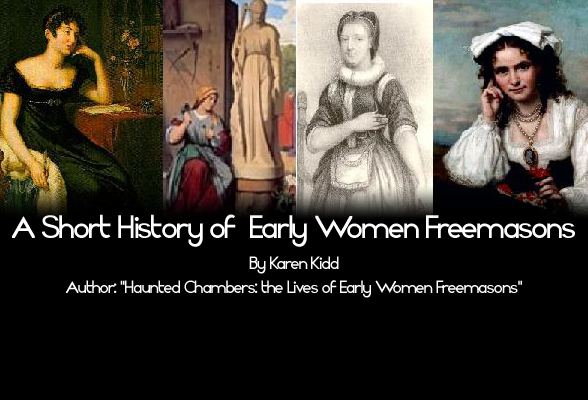 By Karen Kidd
By Karen Kidd
Author of “Haunted Chambers: the Lives of Early Women Freemasons”
Controversial American author Robert Temple observed “Technology is forbidden when it is not allowed to exist.”
“It is easy to forbid technology to exist in the past because all you have to do is to deny it. Enforcing the ban then becomes a simple matter of remaining deaf, dumb and blind. And most of us have no trouble in doing that when necessary. . . I call it consensus blindness. People agree not to see what they are convinced cannot exist.”
Temple made these comments in his paper “Forbidden Technology”, which is about optical technology, long denied by “experts”, that none-the-less existed for millennia.
“Consensus blindness” long has been the unwritten/unspoken rule among Malecraft Masons, likewise accepted by many non Masons including women, about the existence of early women Freemasons. However, just as there are lenses in Ancient Egyptian archaeological finds dating to the 4th and 5th dynasties at Abydos, so also have women Masons existed throughout all of the modern Freemasonic period[1].
Denying their existence, for centuries, was the expected norm and any Masonic historian who wrote about them had to adopt a sort of double-speak. For instance, 20th Century Masonic scholar Carl Claudy, when he wrote about women Freemasons in his “Masonic Harvest”, spent the first page of that chapter stating that women could not be Freemasons; then ten pages describing – with continual double-speak – the lives of those women Freemasons.
Claudy, whatever his personal opinions, had no choice but to write about early Women Freemasons in this way. Had he attempted to be more straight-forward, it likely would never have been published. In this way, Claudy and other Masonic writers kept from complete obscurity the lives of these women Freemasons.
Their existence is a fact, despite determined effort to ignore, marginalize and deny it. That effort, however, ongoing for centuries, has done its worst. The very vast majority of early women Freemasons are unknown to us. Finding them can take as much effort as it did to obscure them.
They include:
- Gunnilda the Mason: a female operative mason mentioned by name as living in Norwich in the Calendar of Close Rolls for the year 1256[2].
- Elizabeth St. Leger Aldworth: initiated into her father’s lodge in County Cork in Ireland before the founding of the modern Freemasonry Grand Lodges.
- Hannah Mather Crocker: Grand Mistress of the Femalecraft St. Ann’s Lodge in Boston during the 1770s.
- Henriette Heiniken: better known as “Madame de Xaintrailles”, a hero of the Napoleonic wars initiated into an otherwise Malecraft Lodge in Paris the early 19th Century.
- Mary Ann Belding Sproul: an early New Brunswick settler initiated into her husband’s Lodge in the early 19th Century.
- Catherine Sweet Babington: a teen-ager when she snuck into her uncles’ lodge in East Kentucky, initiated into that Lodge at the height of the anti-Masonic era spawned by the disappearance of William Morgan.
- Salome Anderson: late 19th Century wealthy matron of Oakland, CA, outed as a Freemason by a respected Masonic publication six years before her death in 1898.
And many more. Late 19th Century Masonic history W. Fred Vernon, writing when Malecraft Masons were a bit more laid back about the subject, commented, “I have no doubt other ancient Lodges have their lady members just as ancient buildings have their haunted chambers.”[3]
I’ve heard my book is a threat to all Freemasonry, Malecraft Masonry in particular. This is no more true than admitting to the existence of their contemporary male brethren is a threat to any part of Freemasonry. All our Brethren who have passed to the Grand Lodge above, be they male or female, are to be remembered and emulated.
While none of these women were Co-Masons, they did pave the way for that part of Freemasonry. And, today, women can become Freemasons without eavesdropping, sneaking into lodges or hiding in furniture.
For more than a century, Freemasonry has operated in three parts. There is Malecraft Masonry, there is Femalecraft Masonry and there is Co- or Mixed Masonry. And we know this system can work, largely before it does.
And so it will continue with the past duly recalled. I wrote about these women to follow in the tradition of Claudy and other Masonic historians who kept their stories alive. I wrote the truth that this generation, and the next, may find worthy of remembrance.
Listen to the Masonic Central Podcast with Br. Kidd.
[1] Temple’s paper was published in the Summer 2001 edition (Issue 17) of Freemasonry Today and is available online here: http://www.freemasonrytoday.com/17/p11.php
[2] See “Calendar of Close Rolls 1254-1256”, page 366
[3] See “Ars Quatour Coronatorum, Vol. V (1892)“.
